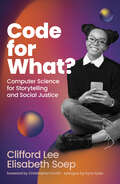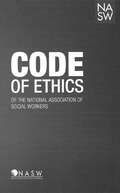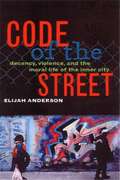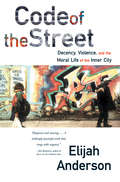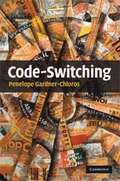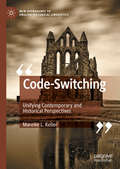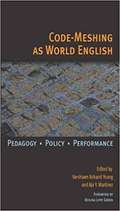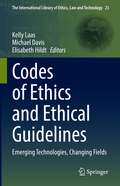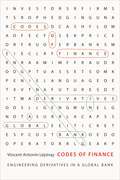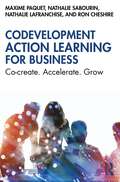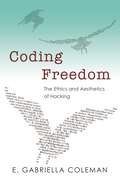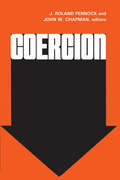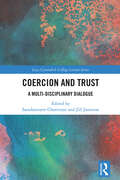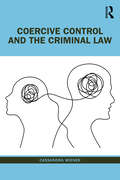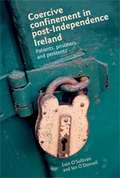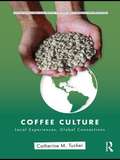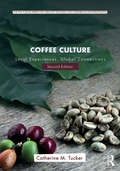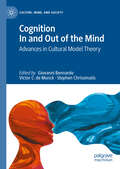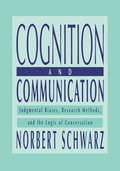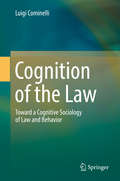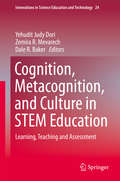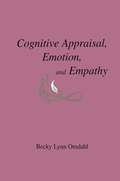- Table View
- List View
Code for What?: Computer Science for Storytelling and Social Justice
by Elisabeth Soep Clifford LeeCoding for a purpose: helping young people combine journalism, data, design, and code to make media that makes a difference.Educators are urged to teach &“code for all&”—to make a specialized field accessible for students usually excluded from it. In Code for What? Clifford Lee and Elisabeth Soep instead ask the question, &“code for what?&” What if coding were a justice-driven medium for storytelling rather than a narrow technical skill? What if &“democratizing&” computer science went beyond the usual one-off workshop and empowered youth to create digital products for social impact? Lee and Soep answer these questions with stories of a diverse group of young people in Oakland, California, who combine journalism, data, design, and code to create media that make a difference. These teenage and young adult producers created interactive projects that explored gendered and racialized dress code policies in schools; designed tools for LBGTQ+ youth experiencing discrimination; investigated facial recognition software and what can be done about it; and developed a mobile app to promote mental health through self-awareness and outreach for support, and more, for distribution to audiences that could reach into the millions. Working with educators and media professionals at YR Media, an award-winning organization that helps young people from underserved communities build skills in media, journalism, and the arts, these teens found their own vibrant answers to &“why code?&” They code for insight, connection and community, accountability, creative expression, joy, and hope.
Code in Context (Primary Socialization, Language and Education)
by Diana S. AdlamIn the 1970s, Basil Bernstein’s work on children’s sociolinguistic codes and his formulation of the contexts in which they are transmitted were the most influential in the field. However, as Diana Adlam points out, neither code nor context as Bernstein saw them can be properly grasped until they are understood in interaction. Originally published in 1977, this collection of papers contains both theoretical and empirical investigations of Bernstein’s ideas, and seeks to make that necessary connection.The study as a whole is concerned primarily with Basil Bernstein’s ideas on the relationship of different familial transmission systems to the way in which children learn to use language. The theoretical chapter stresses Bernstein’s present emphasis on the semantic orientations which different children may be acquiring, and discusses these ideas in relation to work being done elsewhere at the time by other sociolinguistics, particularly in the United States. The empirical chapters provide analyses of how children of different social backgrounds differ in their approach to language use and also show the structural relationship of talk across a variety of specific contexts. Today it can be read against its historical backdrop.
Code of Ethics of the National Association of Social Workers
by National Association of Social WorkersThe NASW Code of Ethics is intended to serve as a guide to the everyday professional conduct of social workers. This Code includes four sections. The first section, "Preamble," summarizes the social work profession's mission and core values. The second section, "Purpose of the NASW Code of Ethics," provides an overview of the Code's main functions and a brief guide for dealing with ethical issues or dilemmas in social work practice. The third section, "Ethical Principles," presents broad ethical principles, based on social work's core values, that inform social work practice. The final section, "Ethical Standards," includes specific ethical standards to guide social workers' conduct and to provide a basis for adjudication.
Code of the Street: Decency, Violence and the Moral Life of the Inner City
by Elijah AndersonThis incisive book examines the code as a response to the lack of jobs that pay a living wage, to the stigma of race, to rampant drug use, to alienation and lack of hope.
Code of the Street: Decency, Violence, and the Moral Life of the Inner City
by Elijah AndersonUnsparing and important. . . . An informative, clearheaded and sobering book.--Jonathan Yardley, Washington Post (1999 Critic's Choice) Inner-city black America is often stereotyped as a place of random violence, but in fact, violence in the inner city is regulated through an informal but well-known code of the street. This unwritten set of rules--based largely on an individual's ability to command respect--is a powerful and pervasive form of etiquette, governing the way in which people learn to negotiate public spaces. Elijah Anderson's incisive book delineates the code and examines it as a response to the lack of jobs that pay a living wage, to the stigma of race, to rampant drug use, to alienation and lack of hope.
Code-Switching
by Penelope Gardner-ChlorosIt is quite commonplace for bilingual speakers to use two or more languages, dialects or varieties in the same conversation, without any apparent effort. The phenomenon, known as code-switching, has become a major focus of attention in linguistics. This concise and original study explores how, when and where code-switching occurs. Drawing on a diverse range of examples from medieval manuscripts to rap music, novels to advertisements, emails to political speeches, and above all everyday conversation, it argues that code-switching can only be properly understood if we study it from a variety of perspectives. It shows how sociolinguistic, psycholinguistic, grammatical and developmental aspects of code-switching are all interdependent, and findings in each area are crucial to others. Breaking down barriers across the discipline of linguistics, this pioneering book confronts fundamental questions about what a 'native language' is, and whether languages can be meaningfully studied outside of the individuals who use them.
Code-Switching: Unifying Contemporary and Historical Perspectives (New Approaches to English Historical Linguistics)
by Mareike L. KellerThis book systematically discusses the link between bilingual language production and its manifestation in historical documents, drawing together two branches of linguistics which have much in common but are traditionally dealt with separately. By combining the study of historical mixed texts with the principles of modern code-switching and bilingualism research, the author argues that the cognitive processes underpinning the human capacity to produce mixed utterances have remained unchanged throughout history, even as the languages themselves are constantly changing. This book will be of interest to scholars of historical linguistics, syntactic theory (particularly generative grammar), language variation and change.
Code-meshing as World English: Pedagogy, Policy, Performance
by Vershawn Ashanti Young Aja Y. MartinezAlthough linguists have traditionally viewed code-switching as the simultaneous use of two language varieties in a single context, scholars and teachers of English have appropriated the term to argue for teaching minority students to monitor their languages and dialects according to context. For advocates of code-switching, teaching students to distinguish between home language and school language offers a solution to the tug-of-war between standard and nonstandard Englishes. <P><P> This volume arises from concerns that this kind of code-switching may actually facilitate the illiteracy and academic failure that educators seek to eliminate and can promote resistance to Standard English rather than encouraging its use. The original essays in this collection offer various perspectives on why code-meshing--blending minoritized dialects and world Englishes with Standard English--is a better pedagogical alternative than code-switching in the teaching of reading, writing, listening, speaking, and visually representing to diverse learners. <P><P> This collection argues that code-meshing rather than code-switching leads to lucid, often dynamic prose by people whose first language is something other than English, as well as by native English speakers who speak and write with accents and those whose home language or neighborhood dialects are deemed nonstandard. <P><P> While acknowledging the difficulties in implementing a code-meshing pedagogy, editors Vershawn Ashanti Young and Aja Y. Martinez, along with a range of scholars from international and national literacy studies, English education, writing studies, sociolinguistics, and critical pedagogy, argue that all writers and speakers benefit when we demystify academic language and encourage students to explore the plurality of the English language in both unofficial and official spaces. <P><P> Contributors: Julie Anne Naviaux; Rosina Lippi Green; Frankie Condon; Gerald Graff; Theresa Malphrus Welford; David A. Jolliffe, Donnelley Hayde, and Jeannie Waller; Katherine Kelleher Sohn; Asao B. Inoue; Min-Zhan Lu and Bruce Horner; Nichole E. Stanford; Vivette Milson-Whyte; Richard Westbury Nettell; Meredith A. Love; Jeremy B. Jones; Kevin Roozen; Elaine Richardson; Santiago Vaquera-Vásquez; Suresh Canagarajah
Codes of Corruption: A Critical Realist Discourse Analysis of Illicit Transactions (Routledge Studies in Critical Realism)
by Karin ZotzmannCorruption is expanding internationally and so are strategic accusations of others being corrupt. It has become quite common for some politicians and their supporters to make false accusations of corruption against opponents in order to win power. A precise understanding of the phenomenon is therefore urgently needed for economic and political governance. The phenomenon has so far been investigated from the disciplines of sociology, criminology, politics, and economics, but rarely with a focus on the actual negotiation of corrupt deals. This is mainly because access to these illegal, often discursively mediated, practices is highly complicated. Empirical studies have therefore either focused quantitatively on the number of cases that came to light or on perceptions of and attitudes towards the phenomenon.Codes of Corruption attempts to fill this gap. It draws on a corpus of videos and audio recordings from Mexico secretly recorded by individuals who were present at the time and later uploaded to a public streaming platform. This corpus was analyzed through a variety of analytical tools to show the interactional and discursive work participants engage in to come to an agreement and, at the same time, the structural configurations that enabled, constrained, and motivated the participants. To capture these multidimensional causal configurations and avoid the pitfalls of reductionism, the theoretical and methodological framework adopted in this research is based on the philosophy of Critical Realism.Through this innovative approach, the book aims to contribute to debates and emerging research agendas in the study of corruption and thus to further the conceptualization of the phenomenon, its causes, and potential remedies. Its results will be of interest to researchers in the above-mentioned disciplines as well as to those working in Critical Discourse Analysis, Critical Realism, Interactional Sociolinguistics, and Pragmatics. Codes of Corruption will also be of interest to a wider audience of governmental and non-governmental institutions that engage in the design of anti-corruption strategies, training, and education.
Codes of Ethics and Ethical Guidelines: Emerging Technologies, Changing Fields (The International Library of Ethics, Law and Technology #23)
by Michael Davis Elisabeth Hildt Kelly LaasThis book investigates how ethics generally precedes legal regulation, and looks at how changes in codes of ethics represent an unparalleled window into the research, innovation, and emerging technologies they seek to regulate. It provides case studies from the fields of engineering, science, medicine and social science showing how professional codes of ethics often predate regulation and help shape the ethical use of emerging technologies and professional practice. Changes in professional ethics are the crystallization of ongoing conversation in scientific and professional fields about how justice, privacy, safety and human rights should be realized in practice where the law is currently silent. This book is a significant addition to this area of practical and professional ethics and is of particular interest to practitioners, scholars, and students interested in the areas of practical and applied ethics.
Codes of Finance: Engineering Derivatives in a Global Bank
by Vincent Antonin LépinayA behind-the-scenes account of the derivatives business at a major investment bankThe financial industry's invention of complex products such as credit default swaps and other derivatives has been widely blamed for triggering the global financial crisis of 2008. In Codes of Finance, Vincent Antonin Lépinay, a former employee of one of the world’s leading investment banks, takes readers behind the scenes of the equity derivatives business at the bank before the crisis, providing a detailed firsthand account of the creation, marketing, selling, accounting, and management of these financial instruments—and of how they ultimately created havoc inside and outside the bank.
Codevelopment Action Learning for Business: Co-create. Accelerate. Grow
by Maxime Paquet Nathalie Sabourin Nathalie Lafranchise Ron CheshireWorkplaces where the focus is on innovation, teamwork and learning have become a reality, thanks to a simple, practical, and effective approach called CAL: Codevelopement Action Learning. This book will help you to create a collaborative and empowering culture in your organization.The CAL method, tools, and theoretical foundations for each component are presented in detail here. Real case studies and research findings on the tangible benefits and impacts of the approach enrich its content. Authored by a dynamic team of CAL business coaches and academics, the knowledge is shared in a straightforward and accessible manner.Business leaders, entrepreneurs, human resources and learning professionals, coaches, facilitators, scholar practitioners, and more will welcome this book’s thought-provoking guidance to co-create solutions, accelerate goals, and grow capabilities for the 21st century.
Coding Freedom: The Ethics and Aesthetics of Hacking
by E. Gabriella ColemanWho are computer hackers? What is free software? And what does the emergence of a community dedicated to the production of free and open source software--and to hacking as a technical, aesthetic, and moral project--reveal about the values of contemporary liberalism? Exploring the rise and political significance of the free and open source software (F/OSS) movement in the United States and Europe, Coding Freedom details the ethics behind hackers' devotion to F/OSS, the social codes that guide its production, and the political struggles through which hackers question the scope and direction of copyright and patent law. In telling the story of the F/OSS movement, the book unfolds a broader narrative involving computing, the politics of access, and intellectual property. E. Gabriella Coleman tracks the ways in which hackers collaborate and examines passionate manifestos, hacker humor, free software project governance, and festive hacker conferences. Looking at the ways that hackers sustain their productive freedom, Coleman shows that these activists, driven by a commitment to their work, reformulate key ideals including free speech, transparency, and meritocracy, and refuse restrictive intellectual protections. Coleman demonstrates how hacking, so often marginalized or misunderstood, sheds light on the continuing relevance of liberalism in online collaboration.
Coercion
by J. Roland Pennock John W ChapmanCoercion, it seems, like poverty and prejudice, has always been with us. Political thinkers and philosophers have been arguing its more direct and personal consequences for centuries. Today, at a point in history marked by dramatic changes and challenges to the existing military, political, and social order, coercion is more at the forefront of political activity than ever before. While the modern state has no doubt freed man from some of the forms of coercion by which he has traditionally been plagued, we hear now from all sectors of society complaints about systematic coerciveness-not only on the national and international levels, but on the individual level as well.
Coercion and Social Welfare in Public Finance
by Jorge Martinez-Vazquez Stanley L. WinerAlthough coercion is a fundamental and unavoidable part of our social lives, economists have not offered an integrated analysis of its role in the public economy. The essays in this book focus on coercion arising from the operation of the fiscal system, a major part of the public sector. Collective choices on fiscal matters emerge from and have all the essential characteristics of social interaction, including the necessity to force unwanted actions on some citizens. This was recognized in an older tradition in public finance which can still serve as a starting point for modern work. The contributors to the volume recognize this tradition, but add to it by using contemporary frameworks to study a set of related issues concerning fiscal coercion and economic welfare. These issues range from the compatibility of an open access society with the original Wicksellian vision to the productivity of coercion in experimental games.
Coercion and Trust: A Multi-Disciplinary Dialogue (Lucy Cavendish College Lecture Series)
by Jill Jameson Saradamoyee ChatterjeeThe first volume in the Lucy Cavendish College Lecture Series, Coercion and Trust, provides a unique, multi-disciplinary dialogue on the complex links between coercion and trust from perspectives in the social sciences, medicine, and literature, combining high-quality academic research with professional recommendations.Part I analyses adolescent-adult relationships in youth fiction alongside research on the sexual coercion of women, and the link between animal and domestic violence. Part II investigates blind trust and coercion in social media grooming, challenges, and solutions to coercion by misinformation. Part III investigates coercion and trust in migration-detention-deportation, kidnapping in violent political campaigns, and sentencing in rehabilitation.The book makes a significant, original contribution to multi-disciplinary research, professional practice, and advanced development, with theoretical and empirical chapters linking theory, practice, and training. This book will be of interest to academic researchers, professional practitioners, and postgraduate students in research and training in multiple fields across the social sciences, humanities, and medicine, for whom there is no comparable book available worldwide.
Coercive Control and the Criminal Law
by Cassandra WienerThis book considers how a phenomenon as complex as coercive control can be criminalised. The recognition and ensuing criminalisation of coercive control in the UK and Ireland has been the focus of considerable international attention. It has generated complex questions about the "best" way to criminalise domestic abuse. This work reviews recent domestic abuse criminal law reform in the UK and Ireland. In particular, it defines coercive control and explains why using traditional criminal law approaches to prosecute it does not work. Laws passed in England and Wales versus Scotland represent two different approaches to translating coercive control into a criminal offence. This volume explains how and why the jurisdictions have taken different approaches and examines the advantages and disadvantages of each. As jurisdictions around the world review what steps need to be taken to improve national criminal justice responses to domestic abuse, the question of what works, and why, at the intersection of domestic abuse and the criminal law has never been more important. As such, the book will be a vital resource for lawyers, policy-makers and activists with an interest in domestic abuse law reform.
Coercive confinement in Ireland: Patients, prisoners and penitents
by Eoin O’Sullivan Ian O’DonnellThis book provides an overview of the incarceration of tens of thousands of men, women, and children during the first fifty years of Irish independence. Psychiatric hospitals, mother and baby homes, Magdalen homes, reformatories and industrial schools, prisons and borstals formed a network of institutions of coercive confinement that was integral to the emerging state. The book, now available in paperback after performing superbly in hardback, provides a wealth of contemporaneous accounts of what life was like within these austere and forbidding places, as well as offering a compelling explanation for the longevity of the system and the reasons for its ultimate decline. While many accounts exist of individual institutions and the factors associated with their operation, this is the first attempt to provide a holistic account of the interlocking range of institutions that dominated the physical landscape and, in many ways, underpinned the rural economy. Highlighting the overlapping roles of church, state, and family in the maintenance of these forms of social control, this book will appeal to those interested in understanding twentieth-century Ireland: in particular, historians, legal scholars, criminologists, sociologists, and other social scientists.
Coffee Culture
by Catherine M. Tucker"The Anthropology of Stuff" is part of a new Series dedicated to innovative, unconventional ways to connect undergraduate students and their lived concerns about our social world to the power of social science ideas and evidence. Our goal with the project is to help spark social science imaginations and in doing so, new avenues for meaningful thought and action. Each "Stuff" title is a short (100 page) "mini text" illuminating for students the network of people and activities that create their material world. From the coffee producers and pickers who tend the plantations in tropical nations, to the middlemen and processors, to the consumers who drink coffee without ever having to think about how the drink reached their hands, here is a commodity that ties the world together. This is a great little book that helps students apply anthropological concepts and theories to their everyday lives, learn how historical events and processes have shaped the modern world and the contexts of their lives, and how consumption decisions carry ramifications for our health, the environment, the reproduction of social inequality, and the possibility of supporting equity, sustainability and social justice.
Coffee Culture: Local Experiences, Global Connections (Routledge Series for Creative Teaching and Learning in Anthropology)
by Catherine M. TuckerCoffee Culture: Local experiences, Global Connections explores coffee as (1) a major commodity that shapes the lives of millions of people; (2) a product with a dramatic history; (3) a beverage with multiple meanings and uses (energizer, comfort food, addiction, flavouring, and confection); (4) an inspiration for humor and cultural critique; (5) a crop that can help protect biodiversity yet also threaten the environment; (6) a health risk and a health food; and (7) a focus of alternative trade efforts. This book presents coffee as a commodity that ties the world together, from the coffee producers and pickers who tend the plantations in tropical nations, to the middlemen and processors, to the consumers who drink coffee without ever having to think about how the drink reached their hands.
Cognition In and Out of the Mind: Advances in Cultural Model Theory (Culture, Mind, and Society)
by Victor C. de Munck Giovanni Bennardo Stephen ChrisomalisThis edited collection presents an agenda for the interdisciplinary study of anthropology and cognitive science. It consists of fifteen chapters written by international experts on the relationship between culture and cognition. This volume is unique in that it includes both inside (i.e., shared mental templates) and outside (i.e., extended, embedded, enactive and ecological) theories of cognition. The contributors come from the diverse disciplinary fields of anthropology, linguistics, archaeology, and cognitive science. The aim is to investigate the mental production of shared knowledge, goals, and desires around which human social life revolves. The coverage spans cultural and linguistic evolution, the importance of local histories, and the role of cultural models to understand and interact with the world. Drawing on cultural model theory, this volume is an invaluable resource for linguists, cognitive scientists, anthropologists, and other social scientists willing to explore and understand how the sharedness of culture can bond us all together across relative cultural differences and (mis)perceived divisions.
Cognition and Communication: Judgmental Biases, Research Methods, and the Logic of Conversation (Distinguished Lecture Series #Vol. 1996)
by Norbert SchwarzPsychological research into human cognition and judgment reveals a wide range of biases and shortcomings. Whether we form impressions of other people, recall episodes from memory, report our attitudes in an opinion poll, or make important decisions, we often get it wrong. The errors made are not trivial and often seem to violate common sense and basic logic. A closer look at the underlying processes, however, suggests that many of the well known fallacies do not necessarily reflect inherent shortcomings of human judgment. Rather, they partially reflect that research participants bring the tacit assumptions that govern the conduct of conversation in daily life to the research situation. According to these assumptions, communicated information comes with a guarantee of relevance and listeners are entitled to assume that the speaker tries to be informative, truthful, relevant, and clear. Moreover, listeners interpret the speakers' utterances on the assumption that they are trying to live up to these ideals. This book introduces social science researchers to the "logic of conversation" developed by Paul Grice, a philosopher of language, who proposed the cooperative principle and a set of maxims on which conversationalists implicitly rely. The author applies this framework to a wide range of topics, including research on person perception, decision making, and the emergence of context effects in attitude measurement and public opinion research. Experimental studies reveal that the biases generally seen in such research are, in part, a function of violations of Gricean conversational norms. The author discusses implications for the design of experiments and questionnaires and addresses the socially contextualized nature of human judgment.
Cognition of the Law: Toward a Cognitive Sociology of Law and Behavior
by Luigi CominelliThis book’s basic hypothesis – which it proposes to test with a cognitive-sociological approach – is that legal behavior, like every form of human behavior, is directed and framed by biosocial constraints that are neither entirely genetic nor exclusively cultural. As such, from a sociological perspective the law can be seen as a super-meme, that is, as a biosocial constraint that develops only in complex societies. This super-meme theory, by highlighting a fundamental distinction between defensive and assertive biases, might explain the false contradiction between law as a static and historical phenomenon, and law as a dynamic and promotional element. Socio-legal scholars today have to face the challenge of pursuing a truly interdisciplinary approach, connecting all the fields that can contribute to building a modern theory of normative behavior and social action. Understanding and framing concepts such as rationality, emotion, or justice can help to overcome the significant divide between micro and macro sociological knowledge. Social scientists who are interested in the law must be able to master the epistemological discourses of different disciplines, and to produce fruitful syntheses and bridge-operations so as to understand the legal phenomenon from each different point of view. The book adopts four perspectives: sociological, psychological, biological-evolutionary and cognitive. All of them have the potential to be mutually integrated, and constitute that general social science that provides common ground for exchange. The goal is to arrive at a broad and integrated view of the socio-legal phenomenon, paving the way for a comprehensive theory of norm-oriented and norm-perceived actions.
Cognition, Metacognition, and Culture in STEM Education: Learning, Teaching and Assessment (Innovations in Science Education and Technology #24)
by Yehudit Judy Dori Zemira R. Mevarech Dale R. BakerThis book addresses the point of intersection between cognition, metacognition, and culture in learning and teaching Science, Technology, Engineering, and Mathematics (STEM). We explore theoretical background and cutting-edge research about how various forms of cognitive and metacognitive instruction may enhance learning and thinking in STEM classrooms from K-12 to university and in different cultures and countries. Over the past several years, STEM education research has witnessed rapid growth, attracting considerable interest among scholars and educators. The book provides an updated collection of studies about cognition, metacognition and culture in the four STEM domains. The field of research, cognition and metacognition in STEM education still suffers from ambiguity in meanings of key concepts that various researchers use. This book is organized according to a unique manner: Each chapter features one of the four STEM domains and one of the three themes--cognition, metacognition, and culture--and defines key concepts. This matrix-type organization opens a new path to knowledge in STEM education and facilitates its understanding. The discussion at the end of the book integrates these definitions for analyzing and mapping the STEM education research.
Cognitive Appraisal, Emotion, and Empathy
by Becky Lynn OmdahlIn a wide array of social sciences, interest in emotion is flourishing. Psychologists, sociologists, anthropologists, communication scholars, and cognitive scientists are exploring human emotions in a variety of contexts. This book speaks to central issues raised by scholars in these disciplines through its review of leading cognitive appraisal theories of emotion, clarification of the nature of empathy, and exploration of how people identify and respond to the emotions hidden within the stories people tell. Intrigue with the separateness and oneness of human existence and experience is evident throughout history. It appears in the teachings of all great religions, in the commentaries of philosophers, and in the perceptions of the most famous characters in classic literature. Perhaps it is this wonderment with human distinction and unity that has spawned interest in empathy as a pervasive human phenomena. This book presents an initial examination of the role of cognitive appraisals in facilitating decoding accuracy and empathy. It compares the leading cognitive appraisal theories and addresses the relationships among appraisal information, empathy, and emotion decoding. Real-life descriptions of emotional experiences are used as the basis for a study examining the relationships between perceived appraisals and perspective-taking, and accurate decoding and empathy. Other studies probe the effects of specific appraisal information on decoding and emotional reactions, and address emotional reactivity to stories and delayed retention. Finally, specific applications are offered for parents, educators, social service employees, writers, advertisers, and people striving for personal well-being and healthy relationships.
